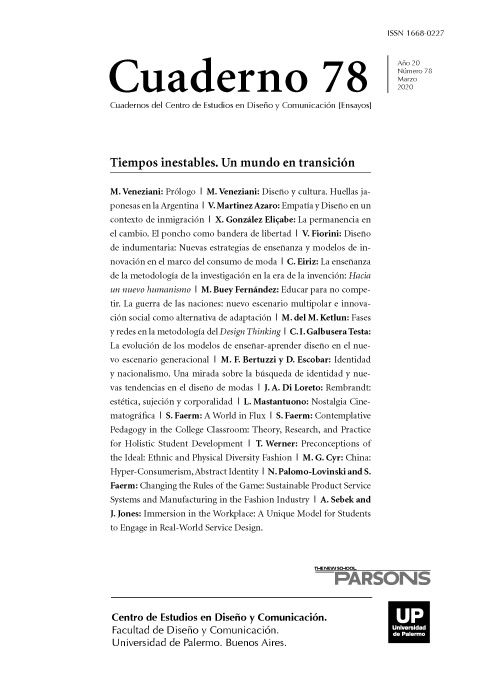La permanencia en el cambio. El poncho como bandera de libertad
Abstract
The poncho has been a present element since ancient times, an essential object in the daily life of the American man. Over the centuries and with different cultural contributions, it has become a symbol of our identity.
The poncho participated in the history of the Nations of South America, both from the Jesuit Missions where they were produced to be marketed, and in tolderias and pillboxes, where they provided protection and shelter.
The poncho was the protagonist of a flourishing textile industry in Argentina at the beginning of the 19th century. When studying the production of raw materials and manufacturing of these textiles, as well as the commercial routes from the productive centers to the metropolis, we can understand social and economic aspects of the times that consolidated the construction of the Republic and enhanced the national identity. It currently appears in the most important international catwalks and street fashion also testifies to its acceptance as a trend. Young Argentine designers are projected in the world of global design, proud of their identity, incorporating ponchos in their collections, with raw materials and novel fabrics, searching for new possible uses that does not recognize categories or protocols.
References
Anderson, B. (1991). Imagined communities: Reflections on the origins and spread of nationalism”. 2da Ed. Londres: Verso.
Corcuera, R. (2017). Ponchos de América. Buenos Aires: Fundación CEPPA. “Culturas indígenas de la Patagonia”. Catálogo de la exposición homónima, Museo Etnológico de Barcelona enero 1984, Museo Arqueológico de Madrid, marzo 1984, Museo Arqueológico de Sevilla, mayo 1984. Ciclo “Las culturas de América en la época del descubrimiento”. Comisión Nacional del V Centenario del Descubrimiento de América.
Nardi, R. L. J. y Rolandi, D. (1978). 100 años de tejido en la Argentina. Ministerio de Cultura y Educación de la Nación: Buenos Aires.
Sarmiento, D. F. (1937). Recuerdos de provincia. Buenos Aires: Talleres gráficos argentinos L. J. Rosso.
Los autores/as que publiquen en esta revista ceden los derechos de autor y de publicación a "Cuadernos del Centro de Estudios de Diseño y Comunicación", Aceptando el registro de su trabajo bajo una licencia de atribución de Creative Commons, que permite a terceros utilizar lo publicado siempre que de el crédito pertinente a los autores y a esta revista.


